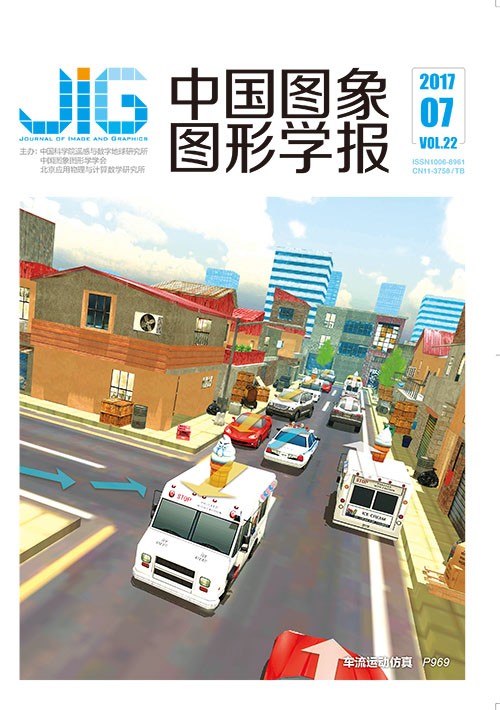
家装设计渲染图增强
摘 要
目的 提出一种亮度、对比度、饱和度三要素与神经网络相结合的家装设计渲染图增强方法。方法 该方法分析了图像增强的3个要素:亮度、对比度和饱和度。算法从下列几个方面着手进行三要素的调节:1)根据原图饱和度和图像融合方法实现亮度和对比度增强;2)采用颜色矩阵实现饱和度增强;3)采用直方图均衡实现对比度进一步增强。这3个要素对图像增强的效果均有贡献,本文为三要素分别赋予一个权值,并引入神经网络方法,自动建立图像亮度分量均值、方差和饱和度分量均值、方差与三要素的权值系数的非线性映射关系。结果 根据图像本身的信息自动获取图像增强三要素的增强系数,实现家装设计渲染图的自适应增强。算法的有效性在不同程度偏灰暗的家装设计渲染图上得到了验证,并与几种经典方法进行了直方图、信息熵、平均对比度(AC)和平均灰度(AG)的定量比较。实验结果显示,本文算法实验结果的直方图具有很少的信息丢失和较好的特征保持,与遗传算法相比,信息熵提高了约0.2,AC值提高了约0.1,AG值提高了约15,本文算法在多数情况下评价指标优于改进的直方图方法。结论 通过对实验结果的直观评价与定量评价,证明与某些现有的方法相比,本文方法适用于不同程度偏灰暗的渲染图,具有较好的通用性,并能达到更优的渲染图像增强效果。
关键词
Enhancement of the rendered images of home decoration design
Dai Yutong1, Jiang Xiaotong1, Tang Hui2(1.Master of Instrument and Meter Engineering, Southeast University, Nanjing 210096, China;2.School of Computer Science and Engineering, Southeast University, Nanjing 211189, China) Abstract
Objective Rendering technology is used in many industries, including home decoration, to improve the visual effects of images or videos. Designers use this technology to produce real and attractive designs. The quality of a rendered image of home decoration design relies on the quality of design parameters, such as sharpness or colorfulness, which depend on the renderer. The rendered images usually have few problems with sharpness because they are always partially gray due to the fixed parameters of the renderer and the multiple parameters of complex light. As such, manual optimization is necessary; this process requires a considerable amount of time and energy of the designer and cannot avoid subjectivity. Few enhancement methods have been developed to enhance the quality of rendered images but cannot yield acceptable results. In this paper, an adaptive enhancement method is proposed to deal with the rendered home decoration design images; the method combines three image enhancement elements, including brightness, contrast, and saturation by the neural networks. Method The proposed method combines different algorithms to improve the three elements of image enhancement and uses the neural networks to learn the subjective parameters of the rendered images. First, the image enhancement method based on the saturation of an original image is used to enhance the brightness and contrast of the image, wherein the saturation component of the color image is computed in the HSI color space. Two different exposed images are generated using weighting function method. The enhanced image is obtained by fusing the original image and the two exposed images. However, contrast enhancement is still insufficiently strong because the algorithm is mainly aimed at enhancing the brightness. Therefore, the histogram equalization is added in to further enhance the contrast because it is simple to understand and calculate. In many conditions, histogram equalization will not produce ideal results due to the noises in images, while this problem is disregarded in the rendered images. In consideration of the similarity between brightness and contrast, the two algorithms are fused with two enhancement factors. Finally, a color matrix is used to enhance the saturation in the RGB color space. The saturation enhancement is also provided as an enhancement factor to be fused with the brightness and the contrast because of the connections among them. The nonlinear mapping relation between the mean and variance of the brightness, the mean and variance of saturation of the original image and the enhancement factors of brightness, contrast, and saturation is established based on the neural networks. Result Conventional image enhancement methods cannot acceptably and automatically enhance the rendered images because the features of the rendered images are special and the enhancement needs to meet human visual system(HVS) as well. In the proposed method, the enhancement factors are automatically determined according to the neural networks established on three different algorithms to realize the adaptive enhancement of the rendered images. The effectiveness of the proposed algorithm is verified on few rendered home decoration design images that are partially gray in different degrees. These experimental images are all designed by the same designer in case of few unnecessary errors. The proposed method is also compared with few classical image enhancement algorithms by the histogram, information entropy, average contrast(AC), and average gray(AG). Experimental results present that the histograms of the processed images have very few information loss and maintain features very well. In addition, information entropy, AC, and AG of the processed images considerably increased compared to those of the original images. Compared to the other methods, the proposed method can achieve a higher increase in degree on these quantitative evaluations. Experimental results show that the proposed method can effectively enhance the rendered images adaptively. Conclusion Experimental results show that the proposed method can properly enhance the brightness, contrast, and saturation of the rendered images with different degrees, which proves its suitability for the enhancement of partially gray rendered images. Furthermore, the proposed method is also easy and fast to compute. However, we cannot deny that this method has few limitations on the conditions wherein the materials are more reflective than normal situations. In addition, the sunlight is simultaneously very strong, resulting in extremely colorful and unreal reflective materials. Hence, the method should be further studied to adapt to few extreme situations.
Keywords
rendered home decoration design images adaptive enhancement enhancement factors neural network quantitative assessment
|



 中国图象图形学报 │ 京ICP备05080539号-4 │ 本系统由
中国图象图形学报 │ 京ICP备05080539号-4 │ 本系统由